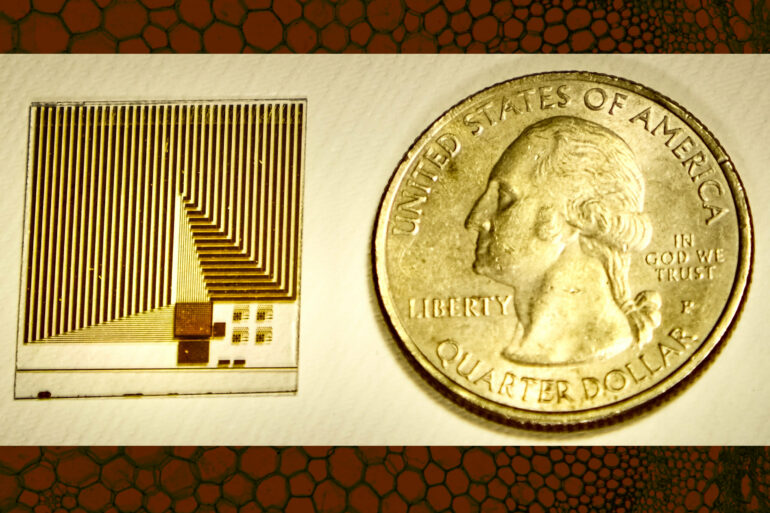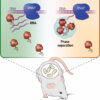Drawing inspiration from natural sensory systems, an MIT-led team has designed a novel sensor that could detect the same molecules that naturally occurring cell receptors can identify.
In work that combines several new technologies, the researchers created a prototype sensor that can detect an immune molecule called CXCL12, down to tens or hundreds of parts per billion. This is an important first step to developing a system that could be used to perform routine screens for hard-to-diagnose cancers or metastatic tumors, or as a highly biomimetic electronic “nose,” the researchers say.
“Our hope is to develop a simple device that lets you do at-home testing, with high specificity and sensitivity. The earlier you detect cancer, the better the treatment, so early diagnostics for cancer is one important area we want to go in,” says Shuguang Zhang, a principal research scientist in MIT’s Media Lab.
The device draws inspiration from the membrane that surrounds all cells. Within such membranes are thousands of receptor proteins that detect molecules in the environment. The MIT team modified some of these proteins so that they could survive outside the membrane, and anchored them in a layer of crystallized proteins atop an array of graphene transistors. When the target molecule is detected in a sample, these transistors relay the information to a computer or smartphone.
This type of sensor could potentially be adapted to analyze any bodily fluid, such as blood, tears, or saliva, the researchers say, and could screen for many different targets simultaneously, depending on the type of receptor proteins used.
“We identify critical receptors from biological systems and anchor them onto a bioelectronic interface, allowing us to harvest all those biological signals and then transduce them into electrical outputs that can be analyzed and interpreted by machine-learning algorithms,” says Rui Qing, a former MIT research scientist who is now an associate professor at Shanghai Jiao Tong University.
Qing and Mantian Xue Ph.D., are the lead authors of the study, which appears in Science Advances. Along with Zhang, Tomás Palacios, director of MIT’s Microsystems Laboratory and a professor of electrical engineering and computer science, and Uwe Sleytr, an emeritus professor at the Institute of Synthetic Bioarchitectures at the University of Natural Resources and Life Sciences in Vienna, are senior authors of the paper.
Free from membranes
Most current diagnostic sensors are based on either antibodies or aptamers (short strands of DNA or RNA) that can capture a particular target molecule from a fluid such as blood. However, both of these approaches have limitations: Aptamers can be easily broken down by body fluids, and manufacturing antibodies so that every batch is identical can be difficult.
One alternative approach that scientists have explored is building sensors based on the receptor proteins found in cell membranes, which cells use to monitor and respond to their environment. The human genome encodes thousands of such receptors. However, these receptor proteins are difficult to work with because once removed from the cell membrane, they only maintain their structure if they are suspended in a detergent.
In 2018, Zhang, Qing, and others reported a novel way to transform hydrophobic proteins into water-soluble proteins, by swapping out a few hydrophobic amino acids for hydrophilic amino acids. This approach is called the QTY code, after the letters representing the three hydrophilic amino acids—glutamine, threonine, and tyrosine—that take the place of hydrophobic amino acids leucine, isoleucine, valine, and phenylalanine.

This photo shows a test setup. The sensor is on left, and it is connected to a small circuit board. A long strip connects that to a larger cellphone-sized circuit board incased in plastic. © MIT researchers
“People have tried to use receptors for sensing for decades, but it is challenging for widespread use because receptors need detergent to keep them stable. The novelty of our approach is that we can make them water-soluble and can produce them in large quantities, inexpensively,” Zhang says.
Zhang and Sleytr, who are longtime collaborators, decided to team up to try to attach water-soluble versions of receptor proteins to a surface, using bacterial proteins that Sleytr has studied for many years. These proteins, known as S-layer proteins, are found as the outermost surface layer of the cell envelope in many types of bacteria and archaea.
When S-layer proteins are crystallized, they form coherent monomolecular arrays on a surface. Sleytr had previously shown that these proteins can be fused with other proteins such as antibodies or enzymes.
For this study, the researchers, including senior scientist Andreas Breitwieser, who is also a co-author in the paper, used S-layer proteins to create a very dense, immobilized sheet of a water-soluble version of a receptor protein called CXCR4. This receptor binds to a target molecule called CXCL12, which plays important roles in several human diseases including cancer, and to an HIV coat glycoprotein, which is responsible for virus entry into human cells.
“We use these S-layer systems to allow all these functional molecules to attach to a surface in a monomolecular array, in a very well-defined distribution and orientation,” Sleytr says. “It’s like a chessboard where you can arrange different pieces in a very precise manner.”
The researchers named their sensing technology RESENSA (Receptor S-layer Electrical Nano Sensing Array).
Sensitivity with biomimicry
These crystallized S-layers can be deposited onto nearly any surface. For this application, the researchers attached the S-layer to a chip with graphene-based transistor arrays that Palacios’ lab had previously developed. The single-atomic thickness of the graphene transistors makes them ideal for the development of highly sensitive detectors.
Working in Palacios’ lab, Xue adapted the chip so that it could be coated with a dual layer of proteins—crystallized S-layer proteins attached to water-soluble receptor proteins. When a target molecule from the sample binds to a receptor protein, the charge of the target changes the electrical properties of the graphene in a way that can be easily quantified and transmitted to a computer or smartphone connected to the chip.
“We chose graphene as the transducer material because it has excellent electrical properties, meaning it can better translate those signals. It has the highest surface-to-volume ratio because it’s a sheet of carbon atoms, so every change on the surface, caused by the protein binding events, translates directly to the whole bulk of the material,” Xue says.
The graphene transistor chip can be coated with S-layer-receptor proteins with a density of 1 trillion receptors per square centimeter with upward orientation. This allows the chip to take advantage of the maximum sensitivity offered by the receptor proteins, within the clinically relevant range for target analytes in human bodies.
The array chip integrates more than 200 devices, providing a redundancy in signal detection that helps to ensure reliable measurements even in the case of rare molecules, such as the ones that could reveal the presence of an early-stage tumor or the onset of Alzheimer’s disease, the researchers say.
Thanks to the use of QTY code, it is possible to modify naturally existing receptor proteins that could then be used, the researchers say, to generate an array of sensors in a single chip to screen virtually any molecule that cells can detect. “What we are aiming to do is develop the basic technology to enable a future portable device that we can integrate with cell phones and computers, so that you can do a test at home and quickly find out whether you should go to the doctor,” Qing says.
More information:
Rui Qing et al, Scalable biomimetic sensing system with membrane receptor dual-monolayer probe and graphene transistor arrays, Science Advances (2023). DOI: 10.1126/sciadv.adf1402. www.science.org/doi/10.1126/sciadv.adf1402
Provided by
Massachusetts Institute of Technology
This story is republished courtesy of MIT News (web.mit.edu/newsoffice/), a popular site that covers news about MIT research, innovation and teaching.
Citation:
New sensor mimics cell membrane functions, may enable screening of hard-to-diagnose cancers (2023, July 21)



